MP32
| Location: Speed | Australian Soil Classification: Hypercalcic, Subnatric, Yellow SODOSOL (thick sandy surface horizons). |
| General Landscape Description: Midslope of a north-south beach ridge (4% slope). | |
| Geology: Quaternary Woorinen Formation overlying Tertiary Parilla Sandstone. | |
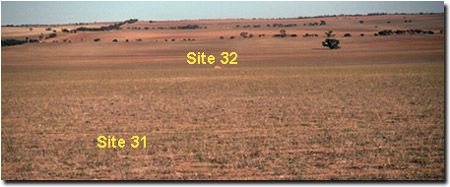 Site MP31 & MP32 Landscape |
Soil Profile Morphology:
Surface Soil
| A1 | 0-10 cm | Brown (7.5YR4/4); sand; loose surface condition; structureless (single grain); very weak consistence moist; pH 7.9; abrupt and smooth change to: | 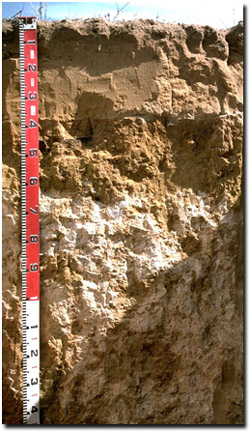 Site MP32 Profile |
| A21 | 10-30 cm | Strong brown (7.5YR5/6); sand; structureless (single grain); very weak consistence moist; pH 7.7; abrupt and smooth change to: | |
| A22 | 30-35 cm | Reddish yellow (7.5YR6/6) conspicuously bleached (7.5YR8/4d); sand; structureless (single grain); loose consistence moist; pH 8.7; sharp and smooth change to: | |
| Subsoil | |||
| B21 | 35-50 cm | Reddish yellow (7.5YR6/6 and 6/8); sandy clay loam (clayey); weakly structured; very firm consistence moist; pH 8.6; gradual and smooth change to: | |
| B22 | 50-60 cm | Yellowish brown (10YR5/6); sandy clay loam (clayey); massive; strong consistence dry; pH 9.5; contains very few (< 2%) soft calcareous nodules; clear and wavy change to: | |
| B23k | 60-110 cm | Reddish yellow (7.5YR7/6) with sub-dominant red (2.5YR5/8) mottles; sandy clay; weakly structured; very firm consistence dry; contains very many (>50%) soft calcareous nodules; pH 9.5; gradual change to: | |
| B24k | 110+ cm | Yellowish red (5YR5/8) with codominant reddish yellow (7.5YR6/6) mottles; sandy clay loam (clayey); weakly structured; strong consistence dry; fine-earth carbonates common (10-20%) in tongues; pH 9.8. | |
Key Profile Features:
- Very sandy profile throughout with a very low available water capacity.
- Strongly alkaline subsoil.
- High accumulation of soft carbonates in the subsoil.
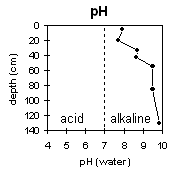 | 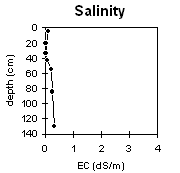 |
The surface is slightly alkaline. The upper subsoil is strongly alkaline, becoming very strongly alkaline at 50 cm. | The salinity rating is low throughout the profile. |
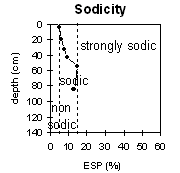 | 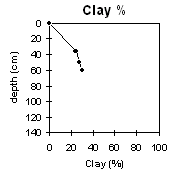 |
The surface soil is non- sodic. The subsoil is sodic. | The clay content increases in the subsoil. |
Whole Profile
- In general, management strategies for all soils should aim to: increase organic matter levels in the surface soil, minimise the degradation of soil aggregates and porosity, promote the development of stable biopores, break up any hardpans, and improve the calcium status of the ion exchange complex. Particularly when sodium plays a significant part i.e. the soil is sodic. Less frequent tillage, using less aggressive implements, and working the soil at optimum moisture conditions can all assist in maintaining soil aggregation and porosity, as well as reducing the breakdown of organic matter. Farming practices on cropping soils such as residue retention, minimum tillage and pasture rotations could be utilised to build up organic matter, reduce erosion risk and increase the soils low inherent fertility.
- The sandy surface horizons have a low plant available water capacity (PAWC) and a low inherent fertility.
- Infiltration of water will be rapid in the sandy surface where water will rapidly move down towards the subsoil. The presence of a conspicuous bleach indicates that this horizon is periodically waterlogged as water sits on the more slowly permeable underlying layers.
- The levels of total nitrogen measured at this pit site are quite low. However, this is best assessed by taking a bulked sample from across the paddock.
- The low wilting point value (i.e. 2.5 %) of the surface horizon indicates that plants will be able to utilise very light rains when the soil is dry, by taking up the water immediately. However, due to the low water storage capacity, plants will soon suffer moisture stress unless further rainfalls occur.
- There would be very high evaporation from these surface horizons as they have very sandy textures and water would evaporate just as quickly as if the water was sitting on the upper surface.
Subsoil (B) Horizons
- The strongly alkaline subsoil suggests that some nutrients (e.g. manganese, zinc, iron, copper) may be poorly available to plants. Boron toxicity can also occur on strongly alkaline soils.
- The subsoil is sodic and has a low exchangeable calcium to magnesium ratio (i.e. 0.8 at 35 cm and decreasing with depth). Dispersion occurs as a result, which leads to conditions that restrict root and water movement in the subsoil.
Comments: At the time of sampling the site was under pasture for sheep.
Profile Described By: Mark Imhof, Paul Rampant and Sonia Thompson (18/4/95).


